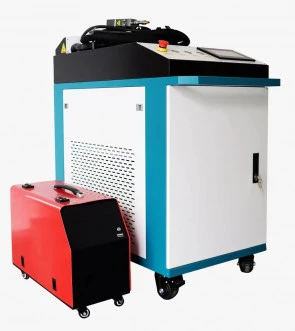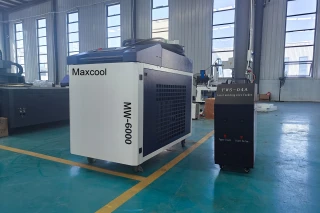Laser Welders
Frequently Asked Questions
Are laser welders expensive?
A typical 3-in-1 laser welding, cleaning and cutting machine with a 1000 – 3000 W fiber laser can be procured for as low as $5,000 while sophisticated models with higher power lasers can be upwards of $100,000 or more.
What can be welded with a laser welder?
Laser beam welding is a versatile process and can be used to create joints in stainless steel, aluminum, HSLA steel, carbon steel, titanium and other metals. At low output powers they can also be used to weld various types of plastics such HDHP, nylon, etc.
Does laser welding require gas?
Yes. Many laser welders come with built-in air assist feature. An inert gas (air, Argon or Nitrogen) plays a key role in the welding process. During the welding process they can control post weld cooling and significantly speed up the welding process. By controlling the cooling rate the gas stream can also impact positively on the mechanical properties of the resulting joint. In the cutting mode, gas stream helps separate the molten pool creating a ridge (cut) along the trajectory of the laser beam.
What type of gas does a laser welder use?
The most frequently used shield gases for laser welding are helium, argon and nitrogen.
What metals can be laser welded?
Although laser welding is most frequently used on mild steel, carbon steel, stainless steel, or aluminum, fabricators are not limited to these materials. Additionally, materials such as coated steel, copper, or titanium can be joined together. Moreover, one of the key advantages of a laser welder is its ability to create hybrid joints between different types of metals.
What are the key advantages of laser welding?
Laser welding reduces the risk of contamination because it is much cleaner than a traditional arc or TIG welding. Additionally, it allows for the bonding of much thinner metals and offers significantly higher tensile and bending strength. It is also more precise and simpler to automate. It also allows creating hybrid joints between dissimilar metals.
What laser sources are best for laser welding?
Fiber, pulsed Nd: YAG, and CO2 lasers are all used in laser welders. With the advancement of fiber laser technology, many manufacturers opt for fiber lasers as the power source given their reliability, compact footprint, and superior beam quality.
How hot is laser welding?
The welding temperature is always determined by the melting point of the materials being joined. Therefore the welding temperature will not depend on the welding technology. However, one of the peculiarities of laser welding is the localized nature of heat generation which limits the molten pull region to just a few mm creating very neat joints and avoiding metal warping that plagues other welding technologies. The output power of the laser welder can be adjusted to fit the particular application and materials being welded.
Are laser welds strong compared with torch or TIG welding?
Yes, laser welding creates neat joints that have great depth-to-width ratios, and are characterized with high tensile strength.
Laser Welders: Precision and Efficiency in Modern Manufacturing
Laser welding has emerged as a transformative technology in modern manufacturing, offering unparalleled precision, speed, and versatility. By utilizing a focused laser beam to melt and fuse materials, laser welders provide a non-contact, high-accuracy solution for joining metals and thermoplastics across various industries.
How Laser Welding Works
Laser welding involves directing a concentrated laser beam onto the workpieces, causing localized melting at the joint interface. The molten material then solidifies to form a strong bond. This process can be performed with or without filler material, depending on the application requirements. Laser welders can be categorized into different types, including pulsed and continuous wave (CW) systems, each offering distinct advantages for specific welding tasks.
Key Advantages of Laser Welding
-
High Precision: Laser welders deliver precise energy delivery, enabling the creation of narrow, deep welds with minimal heat-affected zones.
-
Speed and Efficiency: The rapid energy input of laser welding allows for faster processing times, enhancing productivity in high-volume manufacturing environments.
-
Minimal Distortion: The localized heat input reduces thermal distortion and residual stresses in the welded materials.
-
Clean and Smooth Welds: Laser welding produces clean, smooth welds with minimal spatter, reducing the need for post-weld cleaning and finishing.
-
Versatility: Laser welders can join a wide range of materials, including metals, plastics, and composites, making them suitable for diverse applications.
Applications Across Industries
Laser welders are utilized in various sectors, including:
-
Automotive: Joining components such as body panels, exhaust systems, and battery packs.
-
Aerospace: Welding turbine blades, structural components, and fuel systems.
-
Medical Devices: Manufacturing implants, surgical instruments, and diagnostic equipment.
-
Electronics: Assembling circuit boards, connectors, and enclosures.
-
Energy: Fabricating components for power generation systems, including turbines and heat exchangers.
Selecting the Right Laser Welder
When choosing a laser welder, consider the following factors:
-
Power Requirements: Determine the appropriate laser power based on material thickness and welding speed.
-
Beam Delivery System: Select between fiber-optic or free-space optics based on the application's flexibility and precision needs.
-
Cooling System: Ensure the system includes adequate cooling mechanisms to maintain optimal performance during extended operations.
-
Automation Compatibility: Assess the system's compatibility with robotic arms or automated conveyors for integration into production lines.
-
Safety Features: Verify that the laser welder includes safety interlocks, protective enclosures, and proper ventilation to ensure operator safety.
Conclusion
Laser welders represent a cutting-edge solution for precision joining in modern manufacturing. Their ability to deliver high-quality welds with minimal thermal impact makes them indispensable in industries where accuracy and efficiency are paramount. By selecting the appropriate laser welding system, manufacturers can enhance product quality, reduce operational costs, and maintain a competitive edge in the marketplace.

